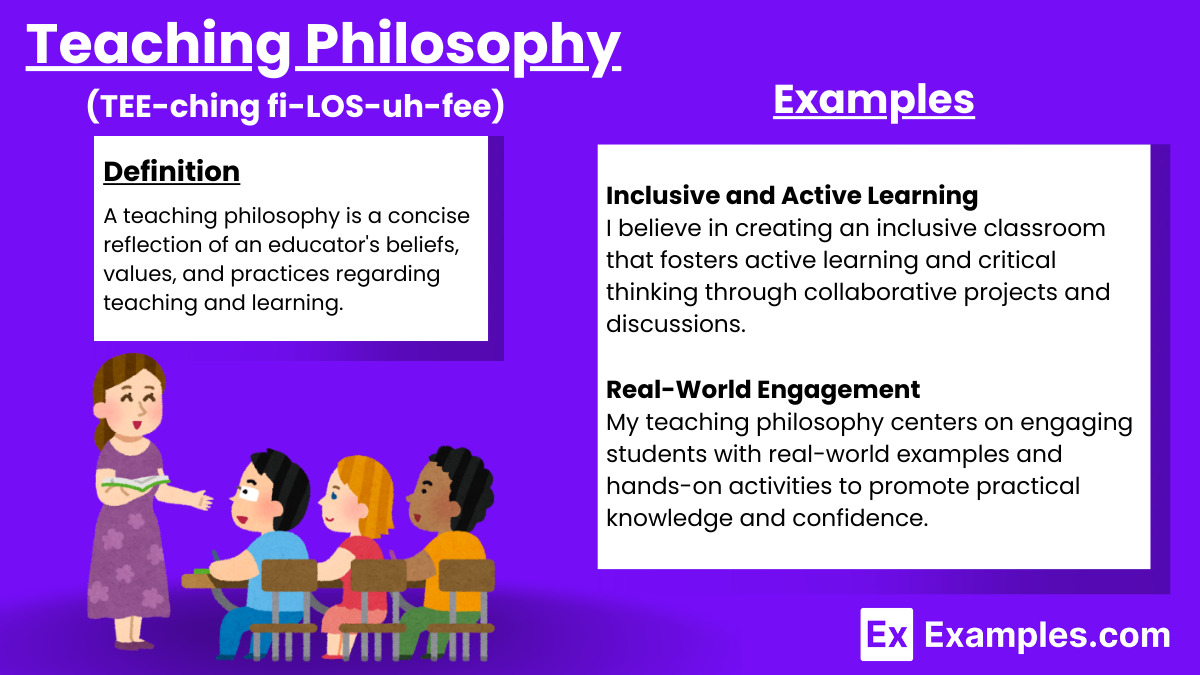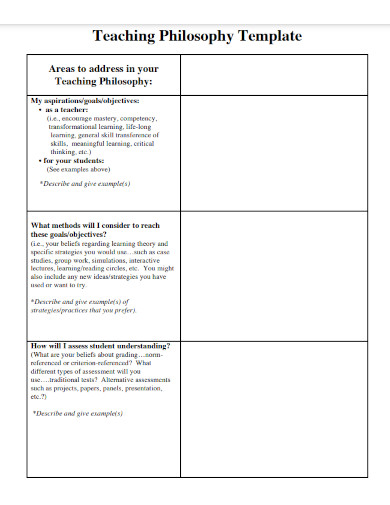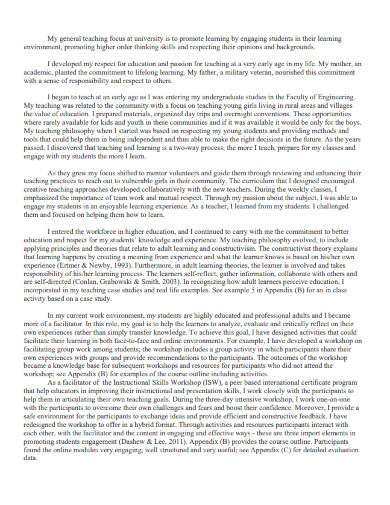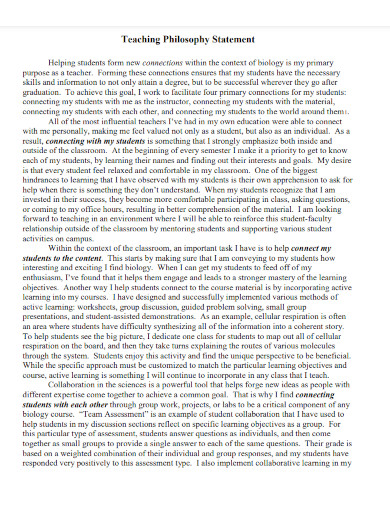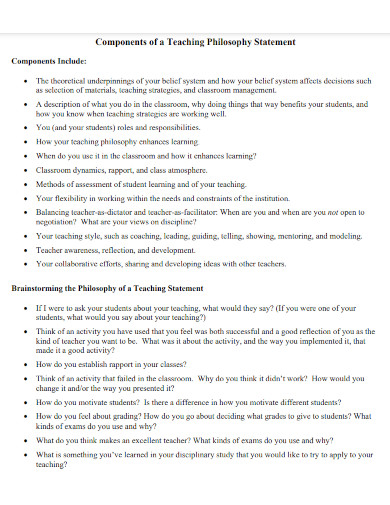15+ Teaching Philosophy Examples to Download
Teaching philosophy is grounded in one’s beliefs, core values, and views on teaching, learning, and action plan for educators. Whether you adhere to a single approach or adapt over time, understanding diverse perspectives on teaching philosophy is invaluable. This article explores various teaching philosophies, offering insights into how different educators approach their practice, and highlighting the importance of reflecting on and articulating one’s own teaching philosophy. By examining these different views, teachers can gain a broader understanding of effective teaching strategies and the underlying principles that guide them.
What is Teaching Philosophy?
A teaching philosophy statement in simple terms is principle-based mainly on how a person views teaching. Teaching philosophy statements are written documents that describe personal values, professional values, personal beliefs, and personal and professional views. This is regarding both teaching and learning.
Teaching Philosophy Statement Examples
1. Student-Centered Learning
“I believe that education should be student-centered, focusing on each student’s unique learning style and strengths. My goal is to create a classroom environment where students feel valued and motivated to engage deeply with the material.”
2. Active Learning
“My teaching philosophy is rooted in active learning. I strive to create interactive lessons that encourage students to participate, ask questions, and collaborate with their peers. This approach helps students develop critical thinking skills and retain information more effectively.”
3. Inclusive Education
“I am committed to creating an inclusive classroom where all students feel welcome and supported. I use diverse teaching strategies to accommodate different learning needs and ensure that every student has the opportunity to succeed.”
4. Growth Mindset
“I believe in fostering a growth mindset in my students. I encourage them to view challenges as opportunities for growth and to persist in the face of difficulties. By promoting a positive attitude towards learning, I help students build resilience and confidence.”
5. Real-World Connections
“My teaching philosophy emphasizes the importance of connecting classroom learning to real-world experiences. I incorporate practical examples and hands-on activities to help students see the relevance of what they are learning and apply it to their lives.”
6. Collaborative Learning
“I believe that learning is a social process. I create a collaborative classroom environment where students work together on projects, share ideas, and learn from each other. This approach not only enhances their understanding but also develops their communication and teamwork skills.”
7. Critical Thinking
“My goal as a teacher is to develop my students’ critical thinking skills. I encourage them to question assumptions, analyze information, and consider multiple perspectives. By fostering a critical mindset, I prepare students to become thoughtful and informed citizens.”
8. Reflective Practice
“I believe that reflection is a key component of learning. I regularly ask my students to reflect on their learning experiences, set goals, and identify areas for improvement. This practice helps them take ownership of their education and become self-directed learners.”
9. Technology Integration
“I integrate technology into my teaching to enhance student learning and engagement. I use a variety of digital tools and resources to create interactive lessons, provide immediate feedback, and facilitate collaboration. Technology also allows me to differentiate instruction and meet the diverse needs of my students.”
10. Culturally Responsive Teaching
“I am dedicated to culturally responsive teaching. I incorporate diverse perspectives into my curriculum and create a classroom environment that respects and values cultural differences. By doing so, I help students develop a deeper understanding of the world and prepare them to thrive in a multicultural society.”
11. Hands-On Learning
“I believe in the power of hands-on learning. I design lessons that involve experiments, projects, and real-life applications to make learning more engaging and meaningful. This approach helps students develop practical skills and a deeper understanding of the subject matter.”
12. Lifelong Learning
“I aim to instill a love of learning in my students. I encourage curiosity, exploration, and a willingness to take risks. By modeling a passion for learning myself, I inspire students to become lifelong learners who continuously seek knowledge and personal growth.”
13. Supportive Environment
“My teaching philosophy centers on creating a supportive and nurturing classroom environment. I build strong relationships with my students, provide emotional support, and create a safe space where they feel comfortable taking risks and expressing themselves.”
14. Interdisciplinary Approach
“I believe in an interdisciplinary approach to teaching. I connect concepts from different subjects to help students see the interconnectedness of knowledge. This approach not only broadens their understanding but also encourages them to think critically and creatively.”
15. Assessment for Learning
“I use assessment as a tool for learning rather than just a measure of performance. I provide regular, formative feedback to help students understand their progress and identify areas for improvement. This approach encourages a growth mindset and helps students take charge of their learning.
Teaching Philosophy Examples for Elementary
Example 1: Student-Centered Learning
My teaching philosophy centers around the belief that each child is unique and learns in their own way. I strive to create a classroom environment where students feel safe, valued, and empowered to explore their interests and strengths. By incorporating hands-on activities, collaborative projects, and individualized instruction, I aim to foster a love of learning and encourage critical thinking. I believe in the importance of building strong relationships with my students and their families to support their educational journey and help them reach their full potential.
Example 2: Holistic Development
I believe in nurturing the whole child, focusing not only on academic growth but also on social, emotional, and physical development. My classroom is a place where children learn to respect themselves and others, develop resilience, and become responsible citizens. I integrate social-emotional learning into my curriculum and provide opportunities for students to practice empathy, cooperation, and problem-solving skills. By creating a supportive and inclusive classroom community, I aim to help students develop a strong sense of self and a lifelong love of learning.
Example 3: Inquiry-Based Learning
My teaching philosophy is grounded in the principles of inquiry-based learning. I encourage students to ask questions, explore, and engage with the material in a meaningful way. By designing lessons that are open-ended and student-driven, I aim to cultivate curiosity and a deeper understanding of the subject matter. I believe that when students are active participants in their learning, they develop critical thinking skills and a sense of ownership over their education. My goal is to create a classroom where students feel confident to take risks, make mistakes, and learn from them.
Example 4: Inclusive Education
I believe that every child deserves an education that meets their individual needs and respects their unique background and experiences. My teaching philosophy emphasizes the importance of inclusive education, where all students, regardless of their abilities or differences, are welcomed and supported. I use differentiated instruction, assistive technology, and collaborative teaching strategies to ensure that every student can access the curriculum and achieve success. By fostering a culture of acceptance and diversity, I aim to help students develop a positive self-image and an appreciation for the differences in others.
Example 5: Constructivist Approach
I subscribe to a constructivist approach to teaching, where students build their own understanding and knowledge through experiences and reflections. I see my role as a facilitator, guiding students as they construct meaning and make connections between new information and their prior knowledge. My classroom is a dynamic environment where students are encouraged to experiment, discuss, and collaborate. Through project-based learning and real-world applications, I aim to make learning relevant and engaging, helping students to see the value and purpose of their education.
Example 6: Growth Mindset
My teaching philosophy is inspired by the concept of a growth mindset, the belief that abilities and intelligence can be developed through dedication and hard work. I strive to instill this mindset in my students by creating a positive and encouraging classroom atmosphere. I celebrate effort, perseverance, and improvement, and I help students understand that mistakes are an essential part of the learning process. By setting high expectations and providing the support needed to meet them, I aim to help students develop resilience, confidence, and a lifelong love of learning.
Example 1: Holistic Development
Philosophy Statement: I believe that education should foster the holistic development of students, addressing their intellectual, emotional, social, and ethical growth. My teaching aims to create a supportive and nurturing environment where students can develop critical thinking skills, emotional intelligence, and a strong sense of ethics.
Implementation:
- Integrated Curriculum: I design my curriculum to include elements that promote not just academic learning but also personal growth, such as ethical discussions, emotional regulation strategies, and social skills development.
- Mentorship: I view my role as a mentor who guides students not just academically but also in their personal development, offering advice and support on a range of issues.
- Community Engagement: I incorporate service-learning projects that encourage students to engage with and contribute to their communities, fostering a sense of social responsibility and ethical awareness.
Example 2: Culturally Responsive Teaching
Philosophy Statement: I believe that culturally responsive teaching is essential in today’s diverse educational landscape. My goal is to create an inclusive learning environment that respects and values the diverse cultural backgrounds of my students, integrating their experiences and perspectives into the learning process.
Implementation:
- Diverse Content: I include diverse voices and perspectives in my curriculum, ensuring that students see themselves reflected in the course material and learn about cultures different from their own.
- Inclusive Pedagogy: I use teaching methods that are inclusive and adaptable to different cultural contexts, such as storytelling, collaborative learning, and culturally relevant examples.
- Student Voice: I encourage students to share their cultural experiences and perspectives in class discussions and assignments, fostering a richer and more inclusive learning environment.
Example 3: Research-Driven Instruction
Philosophy Statement: I believe that integrating research into the teaching process enhances learning by encouraging students to engage deeply with the subject matter and develop critical thinking skills. My approach emphasizes the importance of research and evidence-based learning.
Implementation:
- Research Projects: I design assignments that require students to conduct their own research, analyze data, and present their findings. This helps them develop essential skills in inquiry and analysis.
- Evidence-Based Teaching: I base my teaching strategies on current educational research, continuously updating my methods to incorporate the latest findings in pedagogy.
- Research Mentorship: I mentor students in their research projects, providing guidance and support throughout the research process, from formulating questions to presenting results.
Example 4: Lifelong Learning and Adaptability
Philosophy Statement: I believe that education should prepare students for lifelong learning and adaptability in an ever-changing world. My teaching philosophy focuses on equipping students with the skills and mindset needed to continuously learn, adapt, and thrive in their personal and professional lives.
Implementation:
- Skill Development: I emphasize the development of transferable skills such as critical thinking, problem-solving, and effective communication that students can apply in various contexts.
- Adaptability: I incorporate flexible and adaptive learning activities that encourage students to embrace change and uncertainty, preparing them for the dynamic nature of the modern world.
- Continuous Improvement: I model a commitment to lifelong learning by continuously seeking professional development opportunities and staying current with advancements in my field.
Example 5: Reflective Practice
Philosophy Statement: I believe that reflective practice is key to effective learning and teaching. By encouraging students to reflect on their experiences and learning processes, I help them develop self-awareness and a deeper understanding of the material.
Implementation:
- Reflective Assignments: I include assignments that require students to reflect on their learning experiences, such as reflective journals, self-assessments, and reflective essays.
- Feedback Loops: I provide regular, constructive feedback and encourage students to reflect on this feedback and use it to improve their performance.
- Metacognitive Strategies: I teach metacognitive strategies that help students become more aware of their learning processes and develop skills to monitor and regulate their own learning.
Example 6: Problem-Based Learning
Philosophy Statement: I believe that problem-based learning (PBL) is an effective way to engage students and develop their critical thinking and problem-solving skills. By presenting students with real-world problems, I encourage them to apply their knowledge and skills in meaningful ways.
Implementation:
- Real-World Problems: I design course activities and assignments around real-world problems that are relevant to the course content, encouraging students to apply what they have learned in practical contexts.
- Collaborative Learning: I use group work and collaborative projects as a key component of PBL, helping students learn to work effectively with others and leverage diverse perspectives.
- Facilitative Teaching: I take on the role of a facilitator, guiding students through the problem-solving process and providing support and resources as needed, rather than simply delivering information.
Teaching Philosophy Examples for Higher Education
Example 1: Holistic Development
Philosophy Statement: I believe that education should foster the holistic development of students, addressing their intellectual, emotional, social, and ethical growth. My teaching aims to create a supportive and nurturing environment where students can develop critical thinking skills, emotional intelligence, and a strong sense of ethics.
Implementation:
- Integrated Curriculum: I design my curriculum to include elements that promote not just academic learning but also personal growth, such as ethical discussions, emotional regulation strategies, and social skills development.
- Mentorship: I view my role as a mentor who guides students not just academically but also in their personal development, offering advice and support on a range of issues.
- Community Engagement: I incorporate service-learning projects that encourage students to engage with and contribute to their communities, fostering a sense of social responsibility and ethical awareness.
Example 2: Culturally Responsive Teaching
Philosophy Statement: I believe that culturally responsive teaching is essential in today’s diverse educational landscape. My goal is to create an inclusive learning environment that respects and values the diverse cultural backgrounds of my students, integrating their experiences and perspectives into the learning process.
Implementation:
- Diverse Content: I include diverse voices and perspectives in my curriculum, ensuring that students see themselves reflected in the course material and learn about cultures different from their own.
- Inclusive Pedagogy: I use teaching methods that are inclusive and adaptable to different cultural contexts, such as storytelling, collaborative learning, and culturally relevant examples.
- Student Voice: I encourage students to share their cultural experiences and perspectives in class discussions and assignments, fostering a richer and more inclusive learning environment.
Example 3: Research-Driven Instruction
Philosophy Statement: I believe that integrating research into the teaching process enhances learning by encouraging students to engage deeply with the subject matter and develop critical thinking skills. My approach emphasizes the importance of research and evidence-based learning.
Implementation:
- Research Projects: I design assignments that require students to conduct their own research, analyze data, and present their findings. This helps them develop essential skills in inquiry and analysis.
- Evidence-Based Teaching: I base my teaching strategies on current educational research, continuously updating my methods to incorporate the latest findings in pedagogy.
- Research Mentorship: I mentor students in their research projects, providing guidance and support throughout the research process, from formulating questions to presenting results.
Example 4: Lifelong Learning and Adaptability
Philosophy Statement: I believe that education should prepare students for lifelong learning and adaptability in an ever-changing world. My teaching philosophy focuses on equipping students with the skills and mindset needed to continuously learn, adapt, and thrive in their personal and professional lives.
Implementation:
- Skill Development: I emphasize the development of transferable skills such as critical thinking, problem-solving, and effective communication that students can apply in various contexts.
- Adaptability: I incorporate flexible and adaptive learning activities that encourage students to embrace change and uncertainty, preparing them for the dynamic nature of the modern world.
- Continuous Improvement: I model a commitment to lifelong learning by continuously seeking professional development opportunities and staying current with advancements in my field.
Example 5: Reflective Practice
Philosophy Statement: I believe that reflective practice is key to effective learning and teaching. By encouraging students to reflect on their experiences and learning processes, I help them develop self-awareness and a deeper understanding of the material.
Implementation:
- Reflective Assignments: I include assignments that require students to reflect on their learning experiences, such as reflective journals, self-assessments, and reflective essays.
- Feedback Loops: I provide regular, constructive feedback and encourage students to reflect on this feedback and use it to improve their performance.
- Metacognitive Strategies: I teach metacognitive strategies that help students become more aware of their learning processes and develop skills to monitor and regulate their own learning.
Example 6: Problem-Based Learning
Philosophy Statement: I believe that problem-based learning (PBL) is an effective way to engage students and develop their critical thinking and problem-solving skills. By presenting students with real-world problems, I encourage them to apply their knowledge and skills in meaningful ways.
Implementation:
- Real-World Problems: I design course activities and assignments around real-world problems that are relevant to the course content, encouraging students to apply what they have learned in practical contexts.
- Collaborative Learning: I use group work and collaborative projects as a key component of PBL, helping students learn to work effectively with others and leverage diverse perspectives.
- Facilitative Teaching: I take on the role of a facilitator, guiding students through the problem-solving process and providing support and resources as needed, rather than simply delivering information.
Teaching Philosophy Examples for High School
Example 1: Growth Mindset and Resilience
Teaching Philosophy:
I believe that fostering a growth mindset is crucial for students’ academic and personal development. In my classroom, I emphasize the value of effort, perseverance, and learning from mistakes. I create a supportive environment where students are encouraged to take risks and view challenges as opportunities to grow. By modeling resilience and a positive attitude towards learning, I help students build the confidence and grit necessary to overcome obstacles and achieve their goals.
Example 2: Real-World Connections
Teaching Philosophy:
Education should connect students to the real world, making learning relevant and meaningful. I design my lessons to bridge the gap between classroom concepts and real-life applications. Through project-based learning, community involvement, and interdisciplinary approaches, I aim to show students the practical significance of their studies. This approach not only enhances engagement but also helps students develop critical thinking and problem-solving skills that are essential for their future careers and everyday lives.
Example 3: Collaborative Learning
Teaching Philosophy:
Collaboration is a key component of effective learning. I believe that students learn best when they work together, share ideas, and support each other’s growth. In my classroom, I encourage group activities, peer tutoring, and cooperative projects. By fostering a collaborative learning environment, I help students develop communication, teamwork, and leadership skills. This not only enhances their academic performance but also prepares them for success in a collaborative world.
Example 4: Individualized Instruction
Teaching Philosophy:
Every student is unique, with their own strengths, interests, and learning needs. My teaching philosophy revolves around individualized instruction, where I tailor my teaching strategies to meet the diverse needs of my students. By using formative assessments, differentiated instruction, and personalized feedback, I ensure that each student receives the support and challenge they need to thrive. My goal is to help every student reach their full potential and develop a lifelong love of learning.
Example 5: Integrating Arts and Creativity
Teaching Philosophy:
Creativity and the arts play a vital role in education, enhancing students’ cognitive abilities and emotional well-being. I integrate arts and creative activities into my teaching to make learning more engaging and enjoyable. Whether through visual arts, music, drama, or creative writing, I encourage students to express themselves and explore their creativity. This approach not only enriches their learning experience but also helps them develop critical thinking, empathy, and a deeper appreciation for the world around them.
Teaching Philosophy Essay
Fostering a Growth Mindset
Central to my teaching philosophy is the concept of a growth mindset, as advocated by psychologist Carol Dweck. I believe that intelligence and abilities are not fixed traits but can be developed through dedication and hard work. This perspective is essential in encouraging students to embrace challenges, persist in the face of setbacks, and view effort as a pathway to mastery. To nurture a growth mindset, I emphasize the importance of effort, strategy, and progress over innate ability. I provide constructive feedback that focuses on specific strategies and behaviors, rather than labeling students’ abilities, and celebrate improvements and perseverance alongside achievements.
Creating an Inclusive and Supportive Classroom Environment
An inclusive and supportive classroom environment is vital for student engagement and success. I am committed to creating a space where all students feel valued, respected, and empowered to express their ideas and perspectives. This involves recognizing and addressing diverse learning needs, backgrounds, and experiences. I employ differentiated instruction strategies to cater to varied learning styles and provide multiple means of engagement, representation, and expression. By fostering a culture of mutual respect and collaboration, I encourage students to learn from one another and develop a sense of community and belonging.
Integrating Real-World Applications
Connecting classroom learning to real-world applications is crucial in making education relevant and meaningful. I strive to bridge the gap between theoretical knowledge and practical experience by incorporating real-life examples, case studies, and problem-solving activities into my lessons. This approach not only enhances students’ understanding and retention of concepts but also equips them with critical thinking and problem-solving skills essential for their future endeavors. By demonstrating the practical implications of academic content, I aim to inspire students to see the value and relevance of their education beyond the classroom.
Reflective Practice and Continuous Improvement
As an educator, I am committed to reflective practice and continuous improvement. I regularly assess and refine my teaching methods based on feedback from students, colleagues, and self-reflection. I stay informed about current educational research and best practices and seek professional development opportunities to enhance my skills and knowledge. By modeling a commitment to lifelong learning, I aim to inspire my students to adopt a similar mindset.
Conclusion
In conclusion, my teaching philosophy is grounded in the belief that every student has the potential to succeed when provided with a supportive, inclusive, and engaging learning environment. By fostering a growth mindset, creating a sense of community, integrating real-world applications, and continuously reflecting on and improving my practice, I strive to empower my students to become confident, curious, and capable learners. Education is not merely about imparting knowledge but about inspiring a lifelong love of learning and equipping students with the skills and mindset needed to navigate and contribute to an ever-changing world.
How to Write a Teaching Philosophy?
1. Reflect on Your Beliefs About Teaching and Learning
Consider what you believe about:
- The purpose of education.
- How students learn best.
- The role of a teacher in the learning process.
- The most important outcomes of education.
2. Identify Your Teaching Methods
Think about the strategies and techniques you use or plan to use:
- How do you engage students?
- How do you assess student understanding and progress?
- What instructional methods do you prefer (e.g., lectures, group work, hands-on activities)?
3. Provide Examples
Use specific examples to illustrate your teaching methods and beliefs:
- Describe a successful lesson or activity.
- Share anecdotes or experiences that highlight your approach.
- Explain how you’ve adapted to meet the needs of diverse learners.
4. Discuss Your Goals for Students
What do you hope students gain from your teaching?
- Critical thinking skills.
- Subject-specific knowledge.
- Lifelong learning habits.
5. Explain How You Assess and Reflect on Your Teaching
How do you measure your effectiveness as a teacher?
- Student feedback.
- Self-reflection.
- Professional development activities.
6. Keep It Personal and Specific
Your teaching philosophy should reflect your unique approach and experiences. Avoid generic statements; instead, focus on what makes your teaching style distinctive.
7. Structure Your Statement
A well-organized teaching philosophy might include:
- Introduction: Brief overview of your teaching beliefs.
- Body: Detailed description of your teaching methods, goals, and examples.
- Conclusion: Summary of your teaching philosophy and its implications for your future practice.
8. Revise and Edit
- Ensure clarity and coherence.
- Seek feedback from colleagues or mentors.
- Revise for conciseness and impact.
Why teaching Philosophy is Important?
A teaching philosophy is important for several reasons, serving as a foundational element for educators. Here are key reasons why it’s important:
1. Clarifies Your Teaching Approach
- Articulates Beliefs: It helps you articulate your beliefs about education, learning, and teaching.
- Defines Methods: It clarifies the methods and strategies you use in the classroom.
2. Guides Professional Development
- Reflection: Writing a teaching philosophy encourages self-reflection on your teaching practices and experiences.
- Improvement: It highlights areas for professional growth and improvement.
3. Enhances Communication
- Transparency: It provides transparency to students, colleagues, and administrators about your approach to teaching.
- Expectations: It sets clear expectations for your students about what they can expect from you as an educator.
4. Supports Career Advancement
- Job Applications: A well-crafted teaching philosophy is often required in job applications for teaching positions.
- Promotion and Tenure: It can be a critical component of promotion and tenure dossiers in academic settings.
5. Improves Student Learning
- Consistency: A teaching philosophy helps maintain consistency in teaching practices, which can improve student learning outcomes.
- Alignment: It ensures that your teaching methods are aligned with your educational goals and objectives.
1. Teaching Philosophy Template
2. Teaching Philosophy Sample
3. Teaching Philosophy Statement
What is a teaching philosophy?
A teaching philosophy is a reflective statement outlining an educator’s beliefs, values, and practices about teaching and learning.
Why is a teaching philosophy important?
It guides instructional strategies, shapes classroom environment, and communicates teaching values to students and colleagues.
How do I start writing a teaching philosophy?
Reflect on your teaching beliefs, methods, and goals. Begin with a clear introduction stating your educational principles.
What should be included in a teaching philosophy?
How long should a teaching philosophy be?
Typically, a teaching philosophy is 1-2 pages long, concisely covering key points.
How does a teaching philosophy benefit students?
It provides a consistent, thoughtful approach to teaching, enhancing student learning and engagement.
Can a teaching philosophy change over time?
Yes, it evolves with new experiences, reflections, and educational advancements.
Should I include specific examples in my teaching philosophy?
Yes, concrete examples illustrate your teaching practices and philosophy in action.
How often should I revise my teaching philosophy?
Revisit and update it annually or when significant teaching experiences occur.
Where can I use my teaching philosophy?
Use it in job applications, tenure dossiers, and as a reflective tool for continuous improvement.



